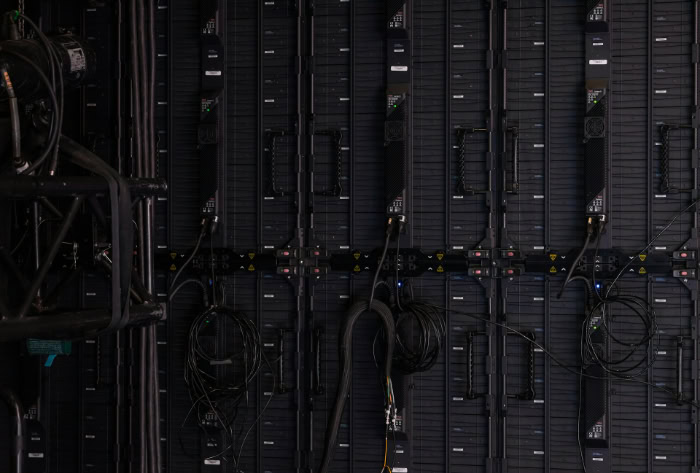What Is an Electronic Document Management System (EDMS)?

Lost files, version confusion, and compliance headaches plague countless organizations. Important information gets buried in shared drives, email inboxes, and local machines, creating inefficiency and risk.
An Electronic Document Management System (EDMS) offers a solution by establishing a centralized, secure hub for all business documents. This system provides a single source of truth, making documents simple to find, control, and audit.
What Is an EDMS
An Electronic Document Management System provides a structured framework for controlling an organization's documents. It moves beyond simple file storage by offering a comprehensive platform to manage the entire lifecycle of information, from its creation to its eventual archiving or deletion.
This system introduces control, organization, and accessibility where there might otherwise be chaos.
Defining the Scope of an EDMS
An Electronic Document Management System is a centralized repository designed to handle digital documents throughout their lifespan. Its functions include tools for creating, storing, indexing, retrieving, tracking, and archiving files.
The system allows users to store documents in a secure, organized manner and index them with metadata, which makes searching for specific information fast and accurate. It also tracks document history and controls access, ensuring that sensitive information is protected and that all actions are recorded.
Ultimately, an EDMS archives or disposes of documents according to predefined rules, helping maintain compliance and reduce clutter.
EDMS, DMS, and ECM Compared
The terms EDMS, Document Management System (DMS), and Enterprise Content Management (ECM) describe related but distinct systems.
- An EDMS is primarily focused on managing structured, official documents such as contracts, engineering drawings, and standard operating procedures. Its strengths lie in version control, security, and managing the formal lifecycle of these records.
- A DMS is a slightly broader category that often includes the capabilities of an EDMS but may also manage a wider array of less structured files. In many contexts, the terms EDMS and DMS are used interchangeably.
- An ECM system has the widest scope. It is designed to manage all of an organization's content, including documents, emails, web content, videos, and social media posts. ECM is suited for enterprise-wide information governance, whereas an EDMS is the ideal choice for organizations with document-centric workflows that require rigorous control.
Identifying the Need for an EDMS
Certain operational challenges signal that an organization could benefit from implementing an EDMS.
- A primary symptom is document sprawl, where files are scattered across personal hard drives, shared network folders, and various cloud storage accounts, making it difficult to locate definitive information.
- Another common issue is version confusion. When multiple employees edit a document, it becomes hard to determine which file is the most current, often leading to mistakes and duplicated work.
- Pressure to meet compliance standards for industries with strict regulatory requirements often necessitates an EDMS to enforce security protocols and provide clear audit trails.
- Finally, cross-team access gaps can slow down projects. When departments are unable to share information efficiently and securely, collaboration suffers and productivity declines. The appearance of these problems indicates that a more structured approach to document control is needed.
Core Benefits of an EDMS

Adopting an Electronic Document Management System moves an organization from cluttered, inefficient file storage to a streamlined and secure information environment. The implementation delivers tangible advantages by improving daily operations, reinforcing security protocols, and strengthening team-based work.
Enhanced Productivity and Findability
An EDMS establishes a single source of truth, consolidating documents into one centralized location. Employees no longer waste valuable time hunting for files across disconnected network drives, email attachments, and local storage.
With powerful search capabilities that use both metadata and full-text content, finding the exact document needed takes only seconds. Faster access to information means less frustration for staff and more time dedicated to productive tasks, accelerating project timelines and daily workflows.
Reduced Risk and Improved Compliance
The system greatly reduces organizational risk by implementing robust security and access controls. Administrators can define granular permissions, ensuring users can only view or modify documents appropriate for their role.
A comprehensive audit trail records every action performed on a document, including who accessed it and when, which is critical for accountability. This level of traceability simplifies the process of demonstrating regulatory compliance and provides a clear record for internal or external audits, protecting the organization from potential penalties and data breaches.
Better Collaboration and Quality Control
Collaboration improves significantly with strong version control. The system tracks all revisions to a document, preventing the common problem of team members accidentally working on outdated drafts.
Features like check-in and check-out prevent conflicting edits, while controlled sharing allows teams to collaborate securely without losing authority over the information. As a result, the quality of work increases, errors are minimized, and the need for rework is substantially diminished.
Essential EDMS Features
The capabilities of an Electronic Document Management System transform document handling from a manual chore into an automated, controlled process. Its functions address the entire lifecycle of a document, from creation and capture to final archival.
These integrated tools work together to create a cohesive and powerful platform for information governance.
Document Capture and Search
An EDMS first simplifies the process of bringing documents into the system. Physical papers can be digitized using scanners, and Optical Character Recognition (OCR) technology automatically converts the scanned images into machine-readable, searchable text.
Once inside the system, documents are indexed with metadata, which are descriptive tags such as date, author, project name, or document type. This structured information, combined with a full-text search engine that examines the entire content of every file, enables users to find specific information with speed and precision.
Access Control and Traceability
To maintain document integrity and security, the system provides robust control mechanisms. Versioning ensures that a complete history of all document revisions is preserved, which prevents users from accidentally working with outdated information.
The check-in and check-out function locks a document while it is being edited, avoiding conflicting changes. Granular permissions allow administrators to define exactly who can view, edit, print, or share specific documents or folders.
Complementing these controls is a detailed audit trail that logs every user action, creating an unchangeable record for accountability and compliance reviews.
Workflow and Lifecycle Management
An EDMS automates routine business processes through customizable workflows. Documents can be routed automatically through a sequence of steps for review and approval, with the system sending notifications and tracking progress at each stage.
This automation reduces delays and ensures procedures are followed consistently. The system also manages the complete document lifecycle according to predefined rules.
Retention policies dictate how long documents must be stored to meet business needs or regulatory requirements. At the end of its useful life, a document can be automatically moved to a long-term archive or securely disposed of.
System Deployment and Integration

Choosing how to deploy an Electronic Document Management System and how it will connect with other business software are foundational decisions. The selected approach determines the system's scalability, maintenance requirements, and overall fit within the organization's existing technology environment.
Proper planning in this area ensures the EDMS enhances, rather than disrupts, established workflows.
Choosing a Deployment Model
Organizations can deploy an EDMS in several ways, each with distinct trade-offs regarding control, cost, and management.
- An on-premises deployment means the software is installed on the company's own servers. This model provides maximum control over data security and infrastructure but requires a significant upfront investment in hardware and licenses, along with ongoing internal IT resources for maintenance and updates.
- A cloud-based model, often offered as Software-as-a-Service (SaaS), hosts the EDMS on the vendor's servers. This approach reduces initial capital expenditure, simplifies scalability, and shifts the management burden to the vendor. However, it offers less direct control and may introduce concerns about data residency for some industries.
- A hybrid deployment combines both models. An organization might keep its most sensitive documents on-premises while leveraging the cloud's flexibility for general collaboration or archiving. This option offers a balance but can create more complex management and integration challenges.
Integrating with Core Applications
For an EDMS to be truly effective, it must function as part of a larger ecosystem, not as a standalone information silo. Integrations with other core business applications create seamless and continuous processes.
For instance, connecting the EDMS with an Enterprise Resource Planning (ERP) or Customer Relationship Management (CRM) system allows documents like invoices or contracts to flow automatically between platforms. In specialized fields such as Architecture, Engineering, and Construction (AEC), integrating the EDMS with Building Information Modeling (BIM) tools ensures that all project-related documentation is centrally managed and linked to the correct models.
Ensuring Performance and Scalability
An EDMS must be designed to accommodate growth in both data volume and user activity. Several performance considerations are critical for long-term success.
The system’s search responsiveness must remain fast, even as the number of documents grows into the millions. The underlying architecture needs to handle an expanding volume of content without degradation.
Finally, the system must support user concurrency, allowing many employees to search, access, and edit documents at the same time without bottlenecks. Planning for these factors ensures the system remains a productive tool as the organization evolves.
An EDMS Implementation Roadmap
A successful Electronic Document Management System implementation is a strategic project that requires careful planning from start to finish. Simply purchasing software is not enough; the transition demands a structured approach to align the technology with business goals and ensure its acceptance across the organization.
Defining Requirements and Selecting a System
The initial phase is grounded in a thorough analysis of organizational needs. This process begins by aligning stakeholders from various departments to define the specific use cases the system must address.
It is critical to document all compliance needs and regulatory obligations, as these will shape security, retention, and auditing features. The organization's existing security posture and integration priorities with other software must also be clearly articulated.
This comprehensive list of requirements becomes the scorecard for evaluating potential vendors and selecting the EDMS solution that best fits the company's operational and technical environment.
Designing the Information Architecture
Once a system is chosen, the next step is to design the logical framework for organizing all content. A well-planned information architecture is essential for long-term governance.
The process involves developing a clear taxonomy, which is the hierarchical structure of folders and classifications that makes document retrieval intuitive. At the same time, standardized metadata fields are established to ensure every file is tagged consistently with descriptive information.
Finally, detailed access policies are created to define user permissions, controlling who can view, edit, and share documents based on their role. A solid architecture ensures the system remains organized and manageable as it grows.
Enabling Widespread Adoption
The ultimate success of an EDMS depends on its users. A focused adoption enablement plan is necessary to manage the human side of the transition.
Effective change management communicates the project’s purpose and prepares employees for new workflows, addressing concerns and building enthusiasm. Comprehensive training programs should be developed for both system administrators and general users, customized to their distinct responsibilities.
Furthermore, creating operational runbooks provides the IT team with documented procedures for maintenance, troubleshooting, and support. A strong focus on user adoption ensures the investment translates into tangible productivity gains.
Conclusion
An Electronic Document Management System provides a powerful solution for organizations seeking to overcome information chaos. By establishing structured, secure, and searchable control over documents, it transforms how information is managed, accessed, and protected.
The full benefits, however, are only realized through diligent implementation. Selecting the right deployment model, establishing solid governance with a well-planned information architecture, and driving user adoption through thoughtful change management are all critical to success.
When these elements come together, an EDMS becomes more than a software tool; it becomes a fundamental asset for operational excellence that delivers sustainable value.


